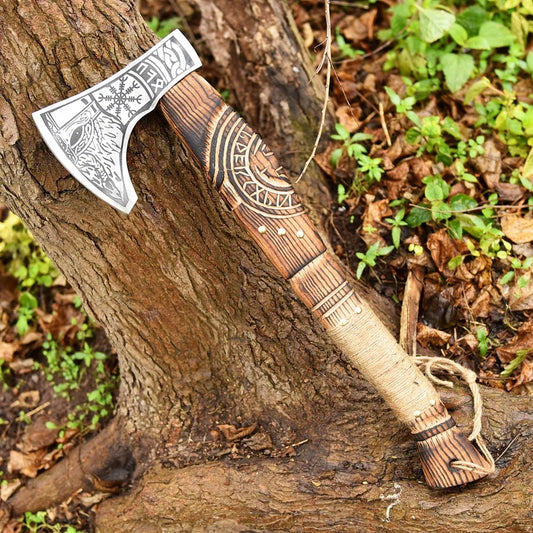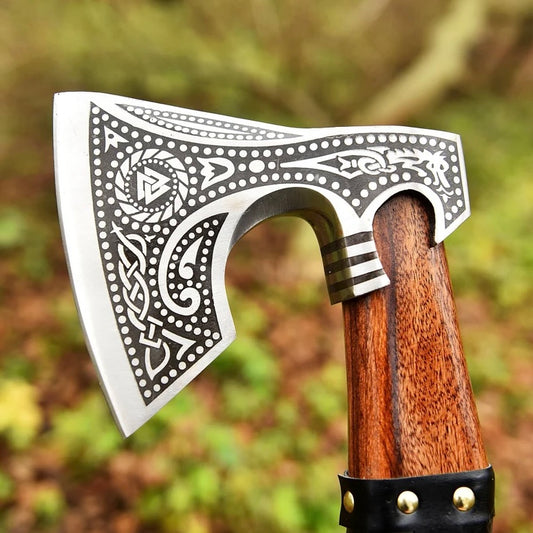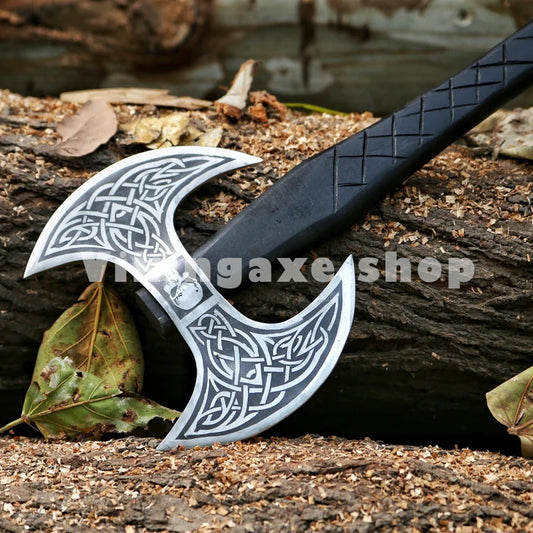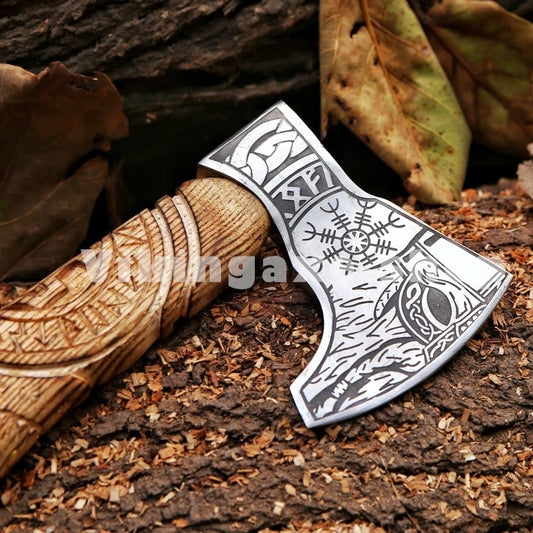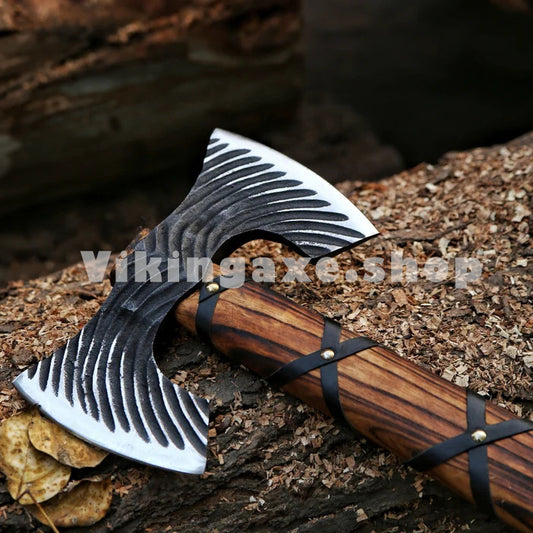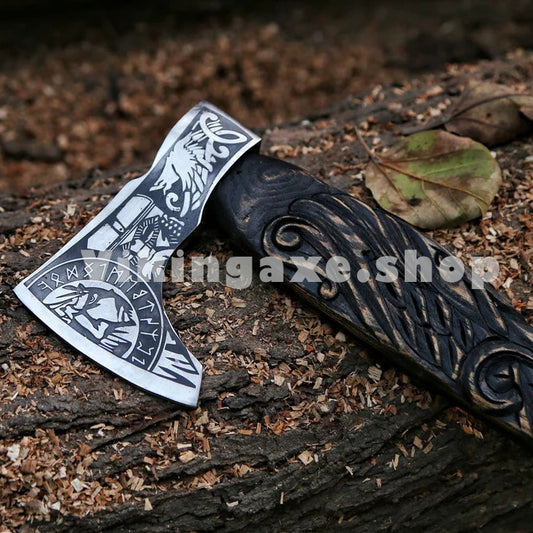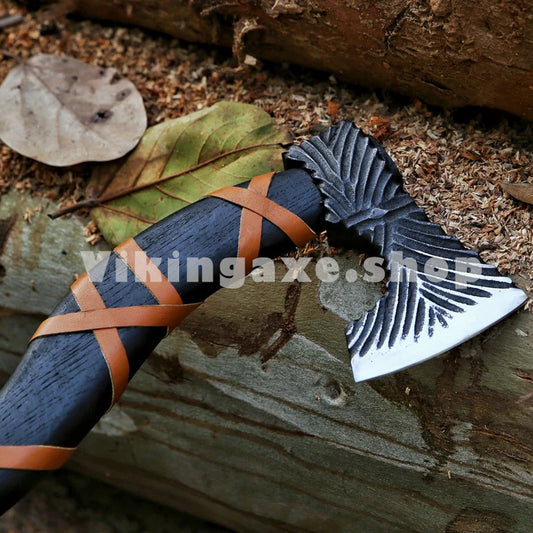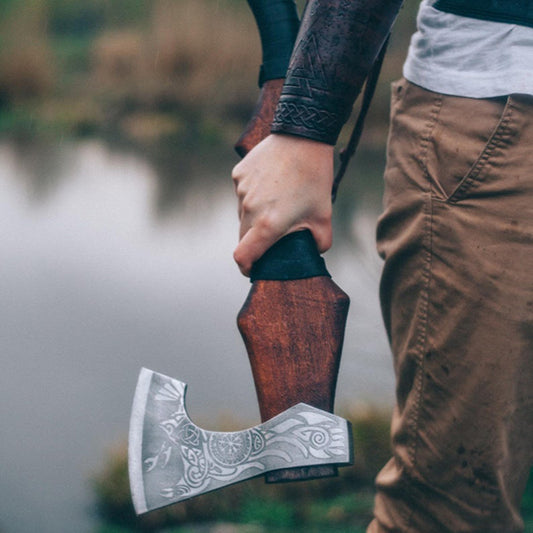
The Revolutionary Facts About Viking Axes
The Revolutionary And Surprising Facts About Viking Axes
What Is A Viking Axe?
Viking Axe is a handy tool with a variety of uses both on the battlefield and at home. At that time, swords were a luxury and only rich men could afford them.
From a historical point of view, the axe was something all the Vikings needed to settle down and know how to use it in their wooded, snowy lands. As a result, axes became weapons commonly used during wartime. Axes like a weapon of war began just as the equipment available was driven on the Viking invasion.
Over time the design, pattern, and texture of the axes changed. Scandinavian people were well acquainted with the art of making axes. Originally, the head was made of stone but was gradually replaced by metal and steel.
WHY ARE THEY NAMED VIKING AXES?
You may have seen Vikings many times with large or small axes in hand giving a horrible or uncontrollable look. The ax was an important part of Viking life not only as a weapon but also as a tool of daily life. To survive in a land of ice and forests, all Vikings needed to know and know everything about axes.
They are historically related to the Vikings.
From the late 8th to the middle of the 11th century, the Vikings were a powerful force and a force in Northern Europe. With their attacks and military movements, they conquered new lands and eventually settled in large numbers. Many of their successes are due to their toughness, their Norse mindset, their vicious fighting style, their unique fighting skills, and their various weapons.
Axes were a common weapon used by Viking soldiers who could not wield a sword for battle.
These axes were light enough to move with one hand but managed to injure the enemy. Viking axes also contributed to the construction of the famous long Viking boats.
The main reasons why the Vikings were so closely associated with axes were that these tools were useful for war and home chores and, perhaps the most important thing was to be able to buy them.
Applications Of Viking Axes
A battle axe was a weapon used by the Viking warriors. Also known as the medieval throw axe, these two axes were easy to create and repair. These weapons were brutal and suited to the wild but powerful blows of the Vikings during the war.
Viking axes were tools for many uses. They could be used in a village, or on a farm for a number of tasks, but when used in battle, they became deadly weapons that could shatter shields and tear weapons as easily as tear logs. Viking war axes are made of one and two different designs, all made of carbon steel or metal heads. Viking axes are easy worldwide as they work effectively.
The Vikings' axes were made in many sizes, from the small hand and throw axes to large battles and the axes used by Viking warriors when they bound themselves in battle. Viking axes are not the same and do not have to be. The Viking Axe was a deadly weapon with a few equal people in the hands of a Norseman.
Surprising Facts About Authentic Viking Axes
The Viking axe ready for battle was not only used in battle, but also as a tool for farms and logging, especially in the construction of their Viking ships.
When you think of real Viking axes, most people tend to think of war axes, and the common picture is that of a large weapon that can only be used by trolls. In fact, the axes of the Viking war were well-balanced, light and fast. They were used not only for rapid, deadly attacks but also for various evil and deceptive movements.
The axe was often a clear weapon in the hands of the poorest men of the Viking period. Even the average farmer had to use a wooden axe to cut and divide the wood. In desperation, the impoverished farmer would simply take his axe and use it to fight.
Fighting axes were designed to look and work in a very different way than farm axes. The heads of the axes were generally of metal and had only one edge.
Construction Of Viking Axes
The heads of the axes usually have a spiral-shaped cross. The opposite part of the head near the edge however was usually the shape of a diamond, providing great strength with the weight of the metal. Some of the axe heads were very thin, perfectly straight. Although these axes were very thin and deceptive to be used for wood splitting, they were prominent in cranium splitting.
If you look at the heads of the first Viking axes since the restoration of the axe, especially the wide and wedge-shaped ones, they immediately show the fact that they were made as a single piece. The hole in the haft (also called the eye) was then removed.
With smaller blades, the blade is folded to keep an eye. The metal piece is then burned on the metal head to the edge. The wrap was balanced in some cases, and in others it was asymmetrical, the weld placed slightly forward in the eye.
Some of the original axe heads have a hot visible hammer (back) of the eye. It is believed that the heads are first formed by the head and then separated from the back by its force. This will create a Y-shaped cross section.
Both Y-arms were joined together to form the eye, after which they were formed and assembled. These eyes are usually shaped like a shield or D, and are not round, and the hammer (back) was stronger and sharper than the sides.
Interestingly, there do not appear to be the double axe-wielding axes of the axe, and they are not mentioned in any Viking stories.
It was also noted that the beams were rarely used in axes during the Vikings to provide protection from automatic cuts, although there is some archaeological evidence that they were used occasionally.
An axe head can be tied to a hat in many ways. Another way is to reduce the eye of the axe and the axe. This will happen to the head that fits snugly on the shaft and will prevent it from slipping away. However the head is tied at the end, the axe should be able to withstand both push and pull.
Although there is almost no evidence of axes used during the Viking era, it is believed that they were probably made using riving.
Useful Techniques For Viking Axes
Axe Tricks
Axes with short shafts are of great benefit because they can be easily hidden. A small axe could be hidden under a coat and used for a sudden attack, and it was usually kept behind a shield.
Some believe that it was more difficult to control the axe than it was to sharpen a sword. With a well-designed axe it is not. The axe is also more valuable than any other sharp weapon because the curved edge absorbs most of the force of the blade. This gives the axe enough power to pierce the post or the helmet.
The sharp tips at the end of the Viking axe were sharp and could be used as part of the case. Tips can also be used for cutting attacks. Tips create serious wounds when used to stab as the axe horn is much more flexible than a sword or point of a spear.
Axes were sometimes used to strike the axe, striking the back of the axe. This was done to discredit his opponent, or in some cases, used against opponents who were considered so insignificant that they did not deserve a fair beating.
It would have seemed impossible for the axe to be thrown away, but when men become desperate, they would do whatever it took to succeed, so learning to throw axes was a lifesaver. .
Another unusual movement with axes is described in Viking sagas. This involves jumping off and hooking the axe head over the wall of the fence to get past the blockade. Another option would be to use an axe on the left, causing the blows to come off the opposing side of the opponent. The axe can be used for a variety of movements due to the shape of the curved head:
The axe head could be used to stab the opponent's ankle, thus causing him to slip and fall. It can also be tied to another part of the body like the neck, forcing a person to move where he does not want to go. The axe can also be used to hook the edge of a shield, pull it out to suppress attacks, or extinguish rivals.
Best Battle Axes
There are two basic types of axes used by the medieval Scandinavian warriors, the long axe and the hand axe. However, between the two species there were many differences:
Blade sizes and sizes vary widely. The Dane (Danish) axe for example had a broad, thin sword, while the bearded axe had more depth, making it more suitable for heavy duty such as chopping wood because of its weight.
The length of the haft (handle) of both types of axes varies. Viking war axes used to be between one and five feet long (between 30 cm and 1.5 meters).
Some axes were engraved with intricate designs. Some axes were fitted with a cap at the end of the haft to protect the skull from damage. Some axes had horns on both the heel and the toe of the bit.
It is interesting to note that nowhere in this article are references to the famous two-winged Viking axe. Although many portraits of the Vikings depict the invading towns with horned hats and double axes, these statues are historically incorrect. There are no historical documents or archaeological evidence that Norse warriors once used a double-breasted axe or wore a horned helmet.
Dane Axe
The Dane axe is an early type of battle axe, primarily used during the transition between the European Viking Age and early Middle Ages. Other names for this axe are the Danish axe or stripped axe, this was a Viking war axe, with its long cutting edge (usually 8 to 12 inches) and a sharp blade at the end, which itself varies from 3 to 4 feet in length. . The Viking soldiers were armed with Dane axes with a sharp metal band attached to the gums for strong edges.
This weapon was so instrumental in the continuation of the Viking war that even King Harold II's personal escorts were armed with it.
Eventually, the opposition saw the advantages of the weapon, and they began developing similar weapons (the Dane axe was also known as the English axe).
The Dane Axe was designed to be used with both hands, and its head was made of a small but strong metal, resulting in a surprisingly lightweight and portable weapon that can be swung with a large amount of control.
Still, it was capable of inflicting a fatal wound by striking just once on its sharp edge.
Bearded Axe
It is believed to have arisen somewhere in Scandinavia around 600 BC, the bearded axe (also known as the skeggox) accentuated a distinct blade design that proved to be beneficial in several ways.
First and foremost, with its extended edge that declined down well below the butt or pole, a bearded axe presented a longer cutting edge as measured from toe to heel.
In the hands of an eligible Viking warrior (it could also be wielded single-handed), it could chop, tear, and chop with lethal force. Gripping the axe’s haft behind the beard also safeguarded the wielder’s hand.
The extraordinary beard design also fulfilled a defensive purpose. By latching an enemy’s weapon behind the beard, a Viking warrior could quickly disarm and blow him down, and in a similar style, could pry a shield out of a soldier’s hand.
Final Thoughts
Viking axes were used to cut down trees or to strike enemy forces, the axe was an important part of Norse growth during the Viking Age. The history of the Viking axes is amazing. I hope this article has helped you to get an idea of those great times. The good news is that with modern technology and online shopping, you can find Viking axe replicas of high quality where over the past few decades it would have taken you a trip to speciality retailers or a metalworker order to get your hands on specialised retailers. thing. . In any case, the Vikings were an interesting, zealous people who wanted to live, even with all their evil. Their tools - and weapons - were simple, but effective. And they changed the history of the West with their movement, their invasion, and their invasion. Not bad for a few farmers and fishermen from cold northern Europe!
